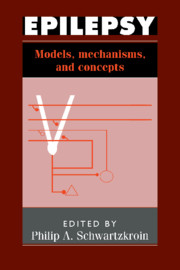16 results
Contributors
-
-
- Book:
- The Causes of Epilepsy
- Published online:
- 05 March 2012
- Print publication:
- 14 April 2011, pp ix-xvi
-
- Chapter
- Export citation
Chapter 4 - Mechanisms of epileptogenesis in symptomatic epilepsy
- from Section 1 - Introduction
-
-
- Book:
- The Causes of Epilepsy
- Published online:
- 05 March 2012
- Print publication:
- 14 April 2011, pp 35-42
-
- Chapter
- Export citation
11 - Sex hormones and how they act in the brain: a primer on the molecular mechanisms of action of sex steroid hormones
- from Part III - Hormones and the brain
-
-
- Book:
- Women with Epilepsy
- Published online:
- 02 November 2009
- Print publication:
- 20 March 2003, pp 112-118
-
- Chapter
- Export citation
Section 3 - ‘Normal’ brain mechanisms that support epileptiform activities
-
- Book:
- Epilepsy
- Published online:
- 03 May 2010
- Print publication:
- 17 June 1993, pp 357-357
-
- Chapter
- Export citation

Epilepsy
- Models, Mechanisms and Concepts
-
- Published online:
- 03 May 2010
- Print publication:
- 17 June 1993
Recent advances
-
- Book:
- Epilepsy
- Published online:
- 03 May 2010
- Print publication:
- 17 June 1993, pp 487-528
-
- Chapter
- Export citation
Index
-
- Book:
- Epilepsy
- Published online:
- 03 May 2010
- Print publication:
- 17 June 1993, pp 529-544
-
- Chapter
- Export citation
Contents
-
- Book:
- Epilepsy
- Published online:
- 03 May 2010
- Print publication:
- 17 June 1993, pp ix-x
-
- Chapter
- Export citation
General introduction
-
-
- Book:
- Epilepsy
- Published online:
- 03 May 2010
- Print publication:
- 17 June 1993, pp 1-18
-
- Chapter
- Export citation
Introduction
- from Section 3 - ‘Normal’ brain mechanisms that support epileptiform activities
-
- Book:
- Epilepsy
- Published online:
- 03 May 2010
- Print publication:
- 17 June 1993, pp 358-370
-
- Chapter
- Export citation
Section 2 - Features of the epileptogenic brain
-
- Book:
- Epilepsy
- Published online:
- 03 May 2010
- Print publication:
- 17 June 1993, pp 199-199
-
- Chapter
- Export citation
Introduction
- from Section 1 - Chronic models in intact animals – concepts and questions
-
- Book:
- Epilepsy
- Published online:
- 03 May 2010
- Print publication:
- 17 June 1993, pp 20-26
-
- Chapter
- Export citation
Frontmatter
-
- Book:
- Epilepsy
- Published online:
- 03 May 2010
- Print publication:
- 17 June 1993, pp i-viii
-
- Chapter
- Export citation
Section 1 - Chronic models in intact animals – concepts and questions
-
- Book:
- Epilepsy
- Published online:
- 03 May 2010
- Print publication:
- 17 June 1993, pp 19-19
-
- Chapter
- Export citation
Introduction
- from Section 2 - Features of the epileptogenic brain
-
- Book:
- Epilepsy
- Published online:
- 03 May 2010
- Print publication:
- 17 June 1993, pp 200-208
-
- Chapter
- Export citation
List of contributors
-
- Book:
- Epilepsy
- Published online:
- 03 May 2010
- Print publication:
- 17 June 1993, pp xi-xiv
-
- Chapter
- Export citation



